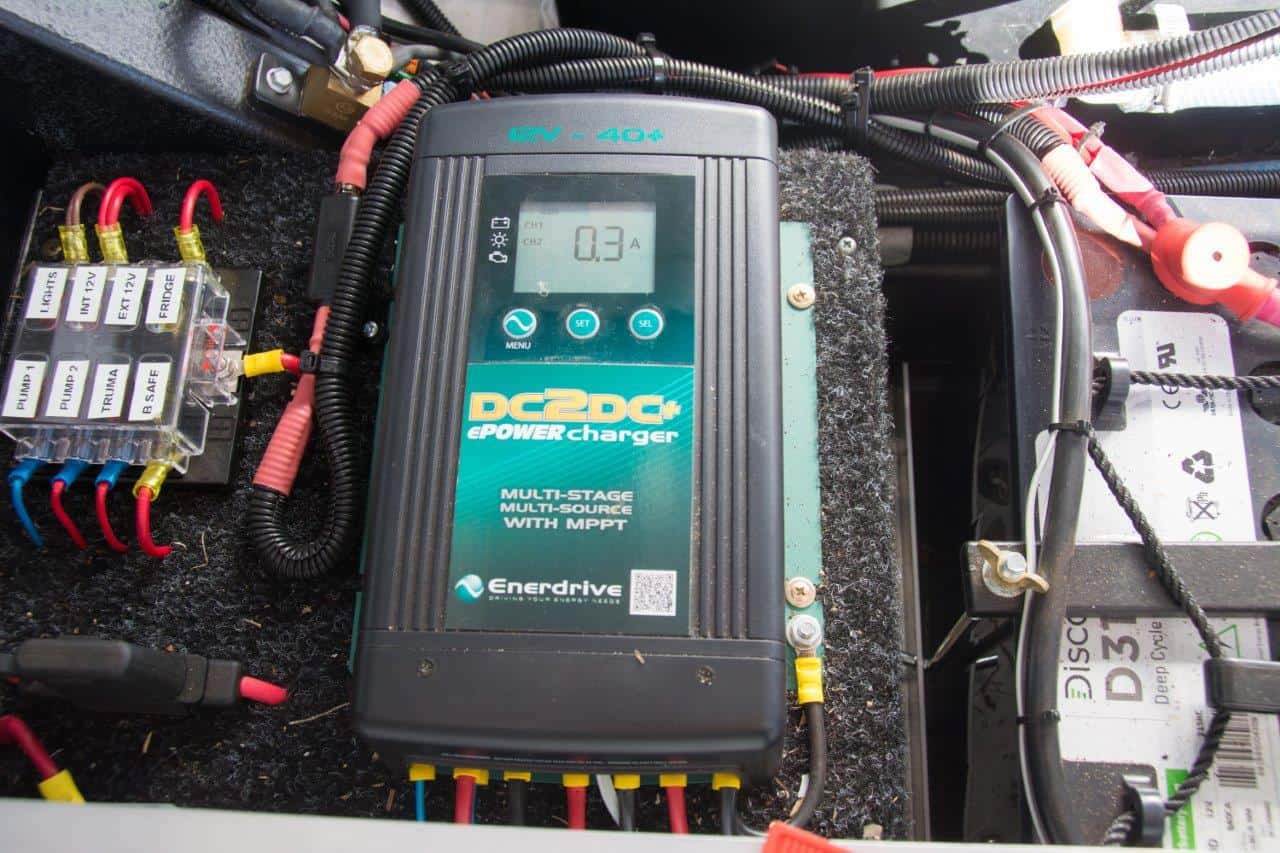
There's no better way to appreciate Australia's wonderful outdoors than through caravanning, camping, 4WDing, or touring. You'll need a dual battery setup to power your gear when parked. The seperate, auxiliary battery powers your refrigerator, lights, phone chargers, and music systems, among other things. As a result, regardless of how much power these devices consume, the vehicle's main battery will stay untouched, ready to start the vehicle when it's time to leave. Unfortunately, your vehicle's alternator will struggle to effectively charge and/or maintain either battery due to differences in charging characteristics between different types of batteries (such as a deep-cycle battery) and batteries at different degrees of charge. This problem is solved by using a DC-DC battery charger. That alone is a compelling argument to purchase one.
What are the benefits of using a DC to DC charger? DC to DC chargers certainly have a number of advantages, and if they didn't, they wouldn't be as popular as they are. Firstly, a DC to DC charger will take into account voltage fluctuations. When you run an electrical cable, you'll notice that the voltage drops. When you have a long cable run or one that has been sized slightly undersize, this is amplified. DC to DC battery chargers should be placed as close as possible to the battery (or batteries) being charged to avoid voltage drop during the charging process. Because by the time the electricity reaches the battery, it has typically lost a significant portion of its'strength,' voltage drop can have a significant impact on its ability to be charged.
Manufacturers have attempted to save fuel by installing smart alternators, which restrict the amount of charge your cranking battery receives, causing the alternator to run less and use less fuel. This may drastically reduce the battery life and makes charging a secondary battery system without a DC to DC charger nearly impossible. The explanation for this is simple: by the time the power reaches your secondary battery, the voltages aren't high enough to charge your deep cycle battery.
The majority of DC to DC chargers will automatically isolate from the start battery, ensuring that you don't wake up with a flat cranking battery. Aside from that, your cranking battery isn't normally designed for low-current use, so when all of your batteries are connected, it will drain at the same pace as your auxiliary batteries, which are designed to run appliances for long periods of time.
Because DC to DC chargers accept diverse battery chemistry, one of the most essential features of a DC to DC charger is that it can charge many types of batteries. Different batteries require different charging profiles, and most DC to DC chargers may be customised to fit the battery you're using. This is especially true if you're using a 12V lithium battery, but it's also crucial to have the correct charger for the job whether you're using an AGM, Gel, Wet, or Calcium battery. You should use a lithium-specific charger if you have lithium batteries.
Furthermore, they charge your batteries with the most appropriate charging profile. A DC to DC not only uses the proper charging profile for your battery type, but it also adjusts the charge based on the battery's current state. They're not a trickle or dumb charger that keeps pumping the same amount of current into your batteries all day. They monitor the voltage of your batteries, as well as their temperature, and regulate the charge to bring them to full capacity in a method that is efficient, safe, and won't cause your battery to explode! The ideal DC to DC charger is one that suits your budget and reliably performs the functions you require. There are certain brands that are better than others, so do your research before investing.
What features should you look for in a DC to DC charger? DC to DC chargers are not all the same, as previously stated. Before you spend your hard-earned money, there are a few things to think about. The maximum charge that the DC to DC charger can make is one of the most essential considerations. Some have a 15-amp limit, while others have 25, 30, 40, and even 50-amp limits. If you buy a DC to DC charger that isn't big enough, you'll have to drive for hours every day to charge your batteries because they are capped at the maximum charge rate. On the other hand, don't pick one that is too large for your arrangement and can damage your batteries.
Is it possible to change any of the settings on a DC to DC charger? Continuing from the previous point, the ability to modify the settings is magical, and some DC to DC chargers excel at it. For example, our Enerdrive DC2DC is as customizable as it gets, which is one of the reasons we support it. Not only will it work with any battery type (even lithium), but you can also customise the maximum charge rate and a slew of other options to suit your needs.
DC to DC battery chargers are now frequently packaged with other goods. The Redarc Manager 30 (available in total vehicle management system here), which is an all-in-one charger and management system, is a nice example of this. There's an ACDC charger, a DCDC charger, an MPPT regulator, a battery monitor, an isolation system, and so on. They're also a lot more expensive, but they're one of the most popular products in higher-end fit-outs.

In order to install and use the DC to DC charger, you may need additional solar relays and other electrical equipment, so ask a few questions before you buy. Some DC to DC chargers are dust and water resistant. Others aren't in any manner, shape, or form, which is a significant factor to consider. Many people install them in attractive electrical boxes that are also dust and water resistant (or mounted inside a vehicle). Don't make the mistake of purchasing a non-waterproof charger with the intention of installing it outside.
DC to DC chargers put in a lot of effort. Anything can be destroyed by heat, and a robust cooling system can extend the life of your DC to DC chargers significantly. Some models don't even have fans, relying solely on heat dissipation through the fins.
Is it powered by the sun? Solar charging used to be handled by a separate unit. Today, however, many high-quality DC to DC chargers include a solar input (although some do not, so be cautious), and you just feed your alternator power into one side and other solar power into the other. If it does offer solar input, double-check that it is compatible with the solar panels you intend to use. Some won't accept more than 23V, therefore you won't be able to utilise ancient house panels or even higher voltage panels (like the Enerdrive options).
The Enerdrive DCDC can handle up to 43V, allowing you to power a far wider range of solar panels. Examine how effective the solar input is, as well as when it activates (as in choosing between the alternator and solar). Some don't work well with solar, so you're better off getting a good MPPT regulator on your own.
What cable size will you require, and where will it be mounted? Don't buy a DC to DC charger until you know exactly where you're going to install it and what cable size you'll need. If you hire an auto electrician to instal it, they'll figure out the cable size, but it's critical to use the appropriate size wires to avoid making the DC to DC charger work harder than it needs to, generating more heat, and maybe causing a fire. If you're charging a lithium battery at 50 amps from a DC to DC charger, you'll be drawing a big amount of power from your alternator, which could be 6+ metres away, so a larger cable.
Alternatives to a DCDC charger - DCDC chargers are rather new, and they were not widely used until recently. A simple manual isolator, Anderson plugs that you remove every time you pull up, or a voltage sensitive relay that disconnects the batteries from each other will suffice. However, none of these allow you to combine different chemical batteries, and you will experience voltage loss over time. Some folks simply use solar power with a good MPPT or PWM regulator to keep their batteries charged, which is fine as well. Many caravans include an Anderson plug that connects to the van batteries and charges them while you're driving, as well as a solar input. The vehicle can charge while you drive (though it suffers with higher voltages because the voltage has fallen so much by the time it reaches the van batteries), and the sun completes the process.
Is it possible to use a DC to DC charger to slow down the charging of your battery? Yes, it can slow down battery charging, especially if you have a huge battery bank that can handle a lot of power. Today's DC to DC chargers are getting larger and greater in capacity, therefore the problem is lessening, but if your battery has 120+ useful amp hours (240ah AGM or 110ah lithium), a smaller DC to DC charger is likely to impede down charging. This is most noticeable in the bulk stage, when the battery bank can receive more charge than the DC to DC charger can deliver. If you had a large battery bank connected to a 25 amp DC to DC charger, for example, it would charge significantly faster than if you connected it directly to your alternator (which is normally rated between 80 and 140 amp).
The installation of a DC to DC charger is typically straightforward, but it must be done correctly, legally, and safely, with the appropriate fuses in place. These move a lot of current and, if not done correctly, can easily cause your vehicle (or trailer) to catch fire. Although we always recommend consulting or hiring an auto electrician, many people do it themselves.
Is a DC to DC charger really necessary? - For many situations, a DC to DC charger is unnecessary, and a VSR or a decent solar setup will suffice. They are, however, an excellent option if you are using various chemistry batteries, your batteries are expensive, or you simply want a basic configuration that always works as well as possible for your batteries. They are relatively inexpensive and easily justifiable in the context of many 12V electrical systems nowadays. However, if you have a cheaper or simpler arrangement and can charge your batteries sufficiently from solar or the alternator, you won't need a DC to DC charger. It might make things better, but it isn't required. It might not be the best for your battery system, but they are well and well justified in many situations, so think about your individual arrangement and acquire one if you think it's necessary.


.png)
Leave a comment